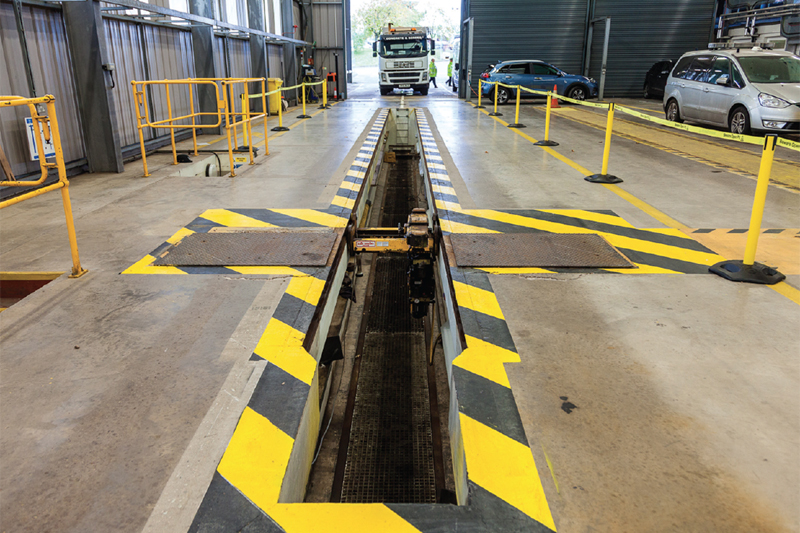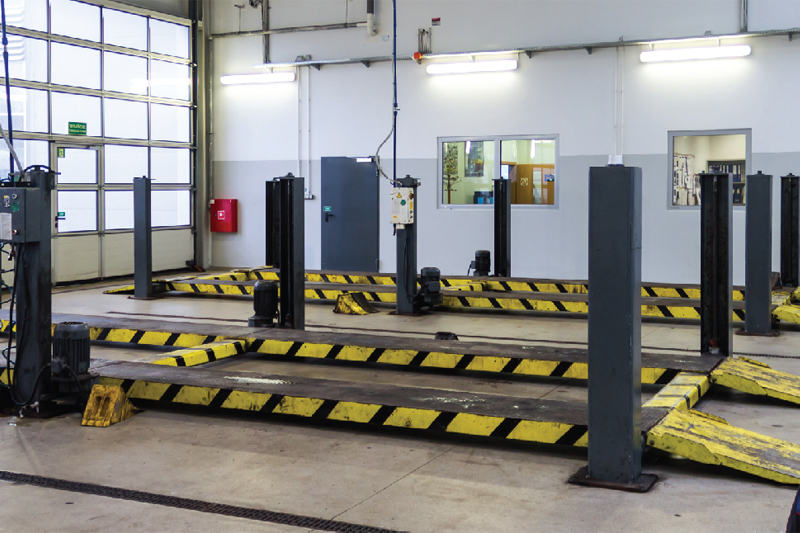
CVW sifts through the latest compliance information from DVSA to make sure you are staying ahead of the curve when it comes to compliance.
Beyond the brake test
There’s much more your brake testing reports can tell you than just a pass or fail. Here, Richard Clements, Vehicle Testing and Roadworthiness Policy Specialist for DVSA, explains why you need to understand them.
For every vehicle you manage, your brake test report can tell you more than whether the vehicle has passed or failed a test. So, you need to give it a good read through – and understand what it’s telling you. The report can tell you if it has met various overall efficiencies, such as that for service, secondary, and park. But it also tells you what you might need to investigate further.
The report can identify individual braking aspects where extra action is needed to avoid further problems that could result in brake failure. This includes bind, time lag, ovality, imbalance, and maximum force. Vehicle details and weight imposed on each axle is shown on each report too.
If a report shows a brake balance across an axle only just passes, what would you do? Would you know how to find out what was causing the problem? You should file the report as a part of your maintenance system and any investigation or repairs should be recorded.
A key part of your maintenance system
The brakes are one of the most important safety systems in your vehicle and should be a key part of the maintenance system.
The braking performance needs checking at every safety inspection. This means they must be monitored and correctly maintained to optimise their efficiency. Poorly maintained brakes may result in the loss of control of a vehicle with dire consequences.
Understanding the brake test report
Operators should always look at their report after the test, regardless of the result. So, even if the brake test shows a pass, you need to look at it to identify items that may be getting worse and need dealing with before they let you down; and for that, you need to understand it.
DVSA has published some guidance to help you better understand brake testing reports. The industry body Logistics UK has also produced some guidance on this subject for members.
Review every brake test report before putting it away and carry out any investigation or repair work as necessary. Make sure the work is done correctly and recorded in the maintenance file. Also, make it available at the next inspection, so the technician can refer to it to see if it has deteriorated.
Remember, a pass result does not always mean there is no action to take. You or your transport manager/maintenance provider may need to review the report to determine how to improve the vehicle’s braking.
The ‘other key headlines’ section shows the way in which your fleet is maintained and how your business is conducted.
The key questions to ask
Here are some of the things you should be reviewing when you get your brake test reports. This list isn’t exhaustive but offers a helpful starting point:
- Are the figures in the report as high as expected? Compare them with sister trucks and/or trailers in the fleet
- Is one vehicle performing differently from a sister vehicle in your fleet?
- Were the vehicles loaded in a similar way and tested in the same manner?
- Does the vehicle have the same type of brakes, is it maintained differently or at another location?
- Are there any differences that could be a cause for investigation? If so, record your investigation and any repairs made to the vehicle
- Are drivers reporting any braking issues, or were any common faults identified and subsequently repaired by the maintenance provider(s)?
A few examples
Possible braking defects
If axle 2 service brake on the offside shows an imbalance of 26% (offside wheel does not lock) when compared to the nearside brake effort, this indicates a possible braking defect so you would need to investigate further.
Offside brake issue
Axle 3 imbalance at 29% with no wheels locking. Although this does not exceed the limit of 30%, it indicates that there is an issue with the offside brake which requires investigation.
Vehicles with split brake systems that the manufacturer has designated as the secondary brake are not assessed as part of the brake inspection. But the brake report may show efficiency readings for these (failures for these can be ignored but this may be reflected in the service braking aspect so you would need to look into this).
How park brake efficiencies are tested
The park brake efficiencies could be tested against the design gross vehicle weight (16%) or the design gross train weight (12%). This is because motor vehicle park brake efficiency should meet the efficiency for whichever is the higher figure.
It’s worth saying that testing equipment, such as roller brake testers, must be maintained and calibrated to ensure the readings are accurate. To conclude, brakes are a critical part of your vehicle, so you can’t afford to leave them without investigation when something is mentioned in the brake testing report. Looking after the brakes will help you keep your vehicles safe to drive.
A note on slack adjusters
DVSA has recently updated its guide to maintaining slack adjusters. These are a feature of brakes that make sure brakes continue to work well, even as the lining wears down. The main issue DVSA frequently sees is where automatic slack adjusters are manually adjusted at service because they are not automatically adjusting correctly. It’s common to read “adjust brakes” on multiple safety inspections (SIs) and then, eventually, the automatic slack adjuster may get replaced.
Manually adjusting the automatic slack adjuster does not fix the problem and can damage the mechanism. The correct way to maintain and check the automatic slack adjuster is covered in DVSA’s updated guidance.

Improved vehicle testing services
Danny Charles, Digital Service Owner (Commercial Vehicle Services) for DVSA, talks about making the organisation’s vehicle testing services better for customers.
In June of last year, DVSA published its Business Plan for 2021/22. It talks about how DVSA will change in response to customer expectations and technological innovations. In short, the organisation wants your experience of its services to exceed your expectations. And this is at the heart of its plans to improve the vehicle testing services it offers.
To do this, DVSA will focus on what you need and make its services simpler and easier to use. At the end of last year, DVSA began getting ready to start some of this work and here are some updates about the changes ahead.
Going digital
One of DVSA’s priorities is to improve how it works with Authorised Testing Facilities (ATFs). Currently, ATF owners do not have live access to data about vehicles and trailers which are tested at their sites. They also cannot view and track their financial transactions with DVSA online.
So, through its vehicle testing transformation project, DVSA is going to give ATFs and other testing customers their own digital account, with live access to this information. ATFs have already told DVSA that this will really help them to manage their lanes more effectively.
Building on existing work
In February 2020, DVSA provided an app for its vehicle standards assessors (VSAs), which lets them enter test results in real time and record defects digitally. You can read more about this part of the project in a previous post by Gordon Thomson on the DVSA’s ‘Moving On’ blog.
In November 2021, DVSA reached a major milestone as the one millionth test was recorded in the app. The design features of the app helps DVSA to improve the accuracy of test records. This directly benefits test history records and the information that can be viewed online.
Being able to record every annual test digitally means DVSA now has a much richer set of data to use when it develops services (such as Check the MOT history of a vehicle) in the future.
Looking ahead
DVSA will also be working with you to improve the vehicle testing application process, including for individuals and businesses who need to get vehicle approvals. DVSA will provide more details about its progress through regular updates on the ‘Moving On’ blog. You can also sign up to get alerts when new blog posts are published.
DVSA wants you to be part of this work and help it to improve its vehicle testing services. So, it will ask you for your views and invite you to test the products that it is developing. You’ll be able to join trade bodies, ATFs, and vehicle operators who have already told the organisation that they would like to support this work.

Emissions value tampering
Finally, Dave Wood, Enforcement Policy Manager for DVSA, outlines the problem surrounding emissions value tampering on the vehicle manufacturer’s plate.
Vehicles that are part of a well-managed and maintained fleet should have little difficulty passing the test. Indeed, many operators take pride in achieving a 100% pass rate. And any good operator should be happy that faults picked up on the test be corrected as quickly as possible. But some operators aren’t like that.
Issues at test
DVSA VSAs have picked up on a small number of heavy vehicles being presented for annual test with some form of tampering carried out to the exhaust emissions data recorded on the vehicle manufacturer’s plate.
The MOT requires the exhaust emissions to be tested to the manufacturer’s type approval values. If this is not available, the vehicle could be tested to an incorrect standard. A recent recording exercise found that the practice is relatively uncommon. But, it does impact government efforts to reduce emissions and could be an indicator of wider poor practice on the operator’s part.
Risks to you as an operator
To ensure that this is not an indication of wider poor practice, DVSA enforcement teams have followed up these tampering reports by either writing to the operator asking for an explanation or paying the operator a visit.
Most cases have resulted in the operator getting a replacement plate, but some operators have been reported to the Traffic Commissioner for public inquiry consideration.
DVSA has also discussed the issue with vehicle manufacturers, and they have offered solutions to reinstate the data if it’s missing. So, if you have discovered you have an issue, contact your local dealer to get the problem resolved – although they will charge for this. This is a much better option than getting a visit from your local DVSA enforcement examiner!








